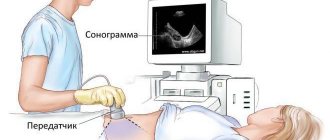Every woman experiences menstrual irregularities. Increased bleeding and lack of blood during menstruation is an obvious pathology. The reasons may be internal and external factors. Sometimes it’s enough to reconsider your lifestyle, establish good nutrition, and everything falls into place. But in some cases, the situation requires referral to specialists and long-term treatment. Menstruation without blood is called “hypomenorrhea”. Primary hypomenorrhea occurs, which occurs in teenage girls, and secondary hypomenorrhea occurs in adult women after a normal menstrual cycle.
What is it - colorless periods
Every woman knows what menstruation looks like and how long it should last. However, there are situations when instead of blood, colorless mucus, similar to egg white, comes out. At the same time, the body’s condition is the same as during menstruation, or even worse. Feeling hot and cold, headaches, stomach aches, nausea to the point of vomiting, mood swings. By all signs, a woman can say that she is having her period, but there is no blood.
The main reason for colorless menstruation is hormonal imbalance. Moreover, the hormone estrogen predominates, which should be present at a high level in the first phase of the cycle. An insufficient amount of progesterone makes it impossible to fully complete the menstrual cycle. The endometrial layer does not grow to a certain level, the uterus is in no hurry to shed. In addition, the pressure drops, while usually it should increase. Low blood circulation prevents menstruation from starting. There is a large amount of mucous transparent discharge. A healthy woman experiences these at the time of ovulation.
Why is there little blood during menstruation?
Most often, a small amount of discharge is not a diagnosis. This is only a symptom of a pathological condition. The main reason for the small amount of blood during menstruation is the thin endometrium (the mucous membrane of the uterine cavity). When the immature endometrium is rejected, the discharge is scanty and spotting. There are primary and secondary hypomenorrhea.
The discharge is brown
Scanty discharge consists of menstrual blood and mucus. Under the influence of oxygen and the acidic environment of the vagina, drops of blood quickly coagulate and come out brown. The reason for this phenomenon is also a hormonal imbalance. Only in this case there are more obvious signs of menstruation. Blood is present - only in small quantities. Under certain circumstances, periods without blood are quite normal:
- taking hormonal pills;
- abortion;
- gynecological surgery;
- climate change;
- menarche;
- menopause period;
- breakdown.
The menstrual cycle is adjusted naturally. For example, it takes about 2 years for girls to get their periods. Menopause lasts about 5 years. During this time, bleeding occurs during menstruation, their complete absence, and severe bleeding.
Instead of normal periods, only clots
Blood discharge during menstruation always contains a small amount of clots. These are particles of the endometrium that comes out with blood during menstruation. This is how the uterus is cleansed, renewed, restored, and prepared for a new cycle. A large number of clots indicates a hormonal imbalance. An imbalance is caused by pathology of the thyroid gland, adrenal glands, brain, and pituitary gland. The situation is typical for women during menopause. For gynecological diseases:
- endomatriosis;
- endometrial polyposis;
- uterine fibroids.
After abortion, childbirth, with an intrauterine device, after drugs to induce menstruation, with varicose veins of the small pelvis.
Reasons for scanty periods
Internal and external factors can cause hormonal imbalance. In some cases, restoring the cycle is quite simple - it is necessary to neutralize the harmful effects.
https://youtu.be/sFyRtTBRalQ
Menstruation without blood during menopause changes is restored after returning to their native land. Or after some time in a new place of residence. Scanty menstruation due to nervous fatigue is restored by taking sedatives, normalizing sleep and rest. It is enough to restore the normal state of the nervous system.
Taking medications, primarily antibiotics, disrupts the menstrual cycle. He should recover next month. Birth control pills significantly change hormonal levels. The first 3 months of menstruation may not occur at all. Or it comes too meager. The same situation occurs after drug withdrawal.
Menstruation with brown discharge indicates pregnancy. Insufficient progesterone leads to spotting. In the future, this is fraught with pregnancy failure. Unusual menstruation occurs when the embryo develops ectopically. Then initially there are scanty periods, then they turn into heavy bleeding.
Norm
Many girls do not monitor their menstrual cycle, do not attach importance to various deviations and do not worry about disruption of the regularity of the cycle. And in vain, because some deviations may indicate serious illness.
Everyone’s menstruation is completely different, so what is normal for some may be pathological for others. But still, doctors have identified a number of signs of normal menstruation:
- Pain during menstruation should either be completely absent, or be barely noticeable and not cause severe discomfort.
- The duration of menstruation varies from 3 to 6 days. Next, there will be a small brownish discharge.
- The amount of blood should not be too large. Yes, some girls have very heavy periods, but this abundance is within the normal range. For those who are sick, it is also necessary to take into account the day of the menstrual cycle, since on the 2-3rd day the abundance of discharge reaches its peak.
For self-observation, you can keep a sign or a monthly calendar. Here you can record their quantity, the nature of the discharge, symptoms and even mood.
Raw food diet
Proper nutrition is the key to health. There are standards according to which a person receives the required amount of minerals, vitamins, and beneficial compounds. At the same time, he feels great. However, in the struggle for an ideal figure, women are faced with a huge number of diets that promise quick results. A raw food diet consists of eating only raw foods. The daily diet consists of:
- fruits and berries – 50%;
- vegetables – 35%;
- products containing starch – 10%;
- concentrates (cottage cheese, dried fruits, nuts, seeds, honey) – 10%;
- seasoning (salt, parsley, onion, vegetable oil, mint) – 1%.
It is believed that consuming such foods restores vitality and improves the functioning of internal organs. Experts recommend using the diet temporarily to lose weight. The optimal option is 60% raw products, 40% heat-treated. It is also recommended to start a strict raw food diet after 30 years. According to numerous observations, vegetarians rarely suffer from gastrointestinal diseases; they almost never have heavy periods. However, an unbalanced diet can cause scanty or absent menstruation.
What to do if you have pathological periods
All problems of the menstrual cycle are eliminated by restoring hormonal levels. Treatment depends on the causes. If there are diseases, doctors prescribe hormonal drugs or cancel them, as is the case with birth control pills. In general, to restore the cycle without gynecological diseases, it is recommended:
- establish a sleep and rest schedule;
- spend more time in the fresh air;
- engage in physical activity, avoid excessive stress;
- provide proper nutrition;
- calm the nervous system;
- visit a gynecologist.
Initially, it may seem that periods without blood are more convenient. However, the woman’s condition is even worse than during full menstruation. Fluid retention in the body, irritability, aggression, headache, nausea, dizziness, tachycardia, headache, hot flashes are a small part of the unpleasant symptoms. A normal menstrual cycle is the key to women's health.
A woman, as you know, is not only a keeper of the hearth, but also a healer. After all, to be beautiful, attractive and healthy, you need not only to study recipes for hair and face masks, but also various medical tricks. Women try to carefully monitor their intimate health. Some people experience problems such as menstruation without blood.
Hypomenorrhea
A frequent cycle disorder is hypomenorrhea, or scanty periods, when blood discharge becomes weak. It is most often accompanied by another pathology - oligomenorrhea, when menstruation lasts fewer days than usual, the duration of bleeding during menstruation is noticeably reduced. Menstruation is considered scanty if the blood loss during all days of menstruation is no more than 50 ml.
For scanty menstruation:
- change color: either too light or dark, brown in the form of strokes;
- can last the usual number of days, but more often they last a shorter period, 1-2 days.
Hypomenorrhea is most often caused by some disease; there are many reasons for scanty periods, and most of them require therapy, since they provoke dysfunction of the reproductive organs and other systems in the body.
Reason No. 1: Underweight and overweight
One category of women carefully looks after themselves and tries to stay in shape. Diets, exercises in fitness centers, gyms and swimming pools are used. The flow of physical activity on an organism exhausted by diets forces it to save energy on everything, including the production of hormones. As a result, menstruation lasts for few days, and they are very scanty. This is a kind of body response to shock from exercise and changes in diet.
Experts have proven that the menstrual cycle and muscle mass in women are connected: muscular representatives of the fair sex often experience scanty periods.
The reason that little blood is released during menstruation and that they have become very short may be excess weight. This is a different category of women - those who are accustomed to eating improperly or who are prone to excess weight due to any concomitant diseases. Fat tissue accumulates estrogen, which disrupts the cycle, leading to scanty menstruation: they become weak, in the form of rare spotting.
Reason #2: Polycystic and other ovarian diseases
One of the most common reasons why little blood is released during menstruation is disturbances in the functioning of the ovaries. It is quite easy to establish this etiology using a blood test, including determining the level of hormones secreted by the body. Typically, the doctor checks the amount of thyroid hormone, insulin, estrogen, androgens, and progesterone. Based on the results, the specialist will determine the likelihood that the woman has a disease such as polycystic ovary syndrome, which is characterized by irregular and scanty periods.
To accurately establish the diagnosis, it is necessary to conduct an ultrasound, which will determine the size of each ovary, the thickness of the endometrium, the condition of the follicles and the presence of their growth, the presence or absence of ovulation, and other pathologies of the reproductive organs caused by disturbances in the functioning of the thyroid gland. If this pathology is not diagnosed in time, the disease can lead to infertility.
With polycystic disease and other hormonal imbalances, in addition to scanty periods, increased oily skin and acne, excess body hair, and weight gain are observed.
This same group of reasons that cause changes in the amount of blood released during menstruation includes disturbances in the functioning of the pituitary gland.
Reason #3: Tuberculosis and other infections
Another very serious reason why menstruation became scanty and began to last several days less is tuberculosis, which affected the patient’s genitals. In addition, other infectious diseases and inflammatory processes in the body, especially in the genitourinary system, can affect the menstrual cycle and significantly harm it. They entail inferiority of the uterine mucosa, which leads to scanty menstruation. Therefore, if a woman notices scanty discharge instead of menstruation, it is important to consult a doctor in order to diagnose such diseases and receive timely treatment.
Reason #4: Abortions and other surgeries
Scanty discharge once a month can be caused by problems with the ovaries. Frequent abortions can easily provoke their improper functioning, since they wreak havoc on the production of hormones in the body, interfering with proper blood circulation in the uterus. Curettage to terminate a pregnancy injures this organ, which also disrupts the menstrual cycle and leads to scanty periods.
The functioning of the reproductive system can also be damaged after other surgical procedures: after operations to remove polyps and fibroids, the quality of the endometrium changes significantly and for the worse; it is damaged, which affects the quantitative and qualitative characteristics of menstruation.
Reason #5: Gynecological diseases
When scanty periods appear, it is imperative to pay attention to the condition of the body, since they can be symptoms of other gynecological pathologies that require treatment and sometimes surgical intervention: these are diseases of the pelvic organs, the formation of polyps or fibroids in the uterus, the development of diseases transmitted through sexual contact .
Reason No. 6: Harmful and hard work
Hypomenorrhea can also occur in completely healthy women whose work involves:
- with heavy physical labor, heavy loads;
- with toxic, harmful substances;
- with radioactive radiation or chemicals.
These working conditions interfere with the proper functioning of the hormonal system to such an extent that they can prevent the onset of ovulation, increasing the concentration of hormones in the body that interfere with the proper functioning of the reproductive organs. This leads to scanty and short periods.
Reason #7: Incipient miscarriage
A woman may not know that she is pregnant, so the onset of menstruation will not alert her, but the arrival of scanty menstruation should be a signal of alarm: small spotting during pregnancy, which can be confused with menstruation, is a symptom of spontaneous abortion, placental abruption , which is very dangerous for the fetus. Such bleeding is an indication for urgent hospitalization of a woman for pregnancy-preserving therapy.
Reason #8: Nervous condition
Frequent stress and being under constant tension can easily cause hypomenorrhea, because such conditions overwork the body and deplete its strength. Other diseases of the nervous system can also cause scanty periods.
Mental trauma, strong emotional experiences and disorders affect the quantitative characteristics of menstruation. Climate changes and prolonged severe pain, which affect the general condition of the body, lead to scanty periods.
Reason #9: Drugs
Scanty periods appear in women who have chosen the wrong hormonal medications, for example, contraceptives, which should only be done with a doctor. Taking any contraceptives entails a decrease in bleeding during menstruation.
Symptoms:
Light menstrual bleeding lasting 1-2 days with scant discharge Light red color of early blood Occasionally a "muddy" type of blood with brownish-black discharge
Causes
The main biological cause of scanty menstruation (hypomenstrual syndrome) is insufficient development of the mucous membrane of the uterus and ovaries. Birth control pills also often lead to a significant reduction in monthly bleeding. Psychologically, this reason is due to a violation of the relationship between menstruation and a woman’s life, as well as possible deviations in her perception of her nature and attitude towards the natural processes of menstruation.
Biological background
In girls who have not yet formed and developed a regular cycle, weak first bleeding is not a cause for concern. In women aged 40 to 50, weak menstruation may be a sign of the onset of menopause.
Psychophysical background
Not all girls and women are able to identify with their monthly cycles and regular bleeding. Some people in our society still often associate menstruation with dirt and impurity, as a symbol of the fact that one should not expect offspring in the near future and there is no need to fulfill the “biological duty” of becoming a mother. For some impressionable women, this assessment does not remain without psychosomatic implications. Many menstruation passes so quickly and with a minimum amount of discharge because it is easier for suffering women to endure it; they subconsciously “rush” their menstruation in order to hide it and quickly get rid of the obsessive feeling of uncleanness of their own body.
Old and reliable - help yourself!
Acupressure You can strengthen the mucus from the lining of the uterus using an acupressure point located on the outside of the base of the nails of the big toes. At their tips there is an acupressure point, with the help of which you can stabilize the functioning of the pituitary glands of the brain and thereby regulate your menstruation. Massage both points in a circular motion 3 times a day for 3 minutes - each finger.
Aromatherapy From aromas, choose first of all marjoram and juniper, they regulate the release of hormones by the body. Place a few drops of your chosen essential oil into an aroma lamp or a cup of water and place it in your bedroom.
Foot baths with increasing water temperature They act as a stimulant and promote increased menstruation. Fill the foot bath with warm water (about 33°C) and place your feet in it. Then add hot water little by little until the water in the bath reaches a temperature of 42 °C. Add water in small portions over a period of about 15 minutes. Finally, dry your feet well and dry them with a towel! Start these baths daily 8 days before the expected start of menstruation.
Prevent illness and stay healthy
Move more in the fresh air, but without heavy sports activity! Strength sports lead to serious disruption of menstrual cycles and weakening of monthly bleeding. Studying the performance of female athletes involved in strength sports proves that cycles depend on a certain amount of fat in the body. If the body consists almost entirely of muscles, menstruation may even disappear completely. Avoid stress! Severe stress and other stress on the body lead to fluctuations in the release of hormones, which can affect menstruation. Learn relaxation techniques to better cope with stress.
Menstruation (menstruation) is a cyclical process in a woman’s body, the so-called genital bleeding. The main function of the female body is reproductive function. In a woman’s body, an egg matures (ovulation), it leaves the ovary and travels through the fallopian tubes to the uterus. In turn, the uterus prepares to meet the egg: the endometrium matures, the thickness of the endometrium increases, the corpus luteum is formed, specific female hormones are produced, the secretory activity of the endometrial glands is prepared for the acceptance (implantation) of a fertilized egg (embryo). If an unfertilized egg enters the uterus, then implantation does not occur, the corpus luteum dies within about 14 days, the vessels narrow, and the dead endometrium is rejected. Then everything is removed from the body, this is actually called menstruation (menstruation).
Each woman's menstrual cycle has its own duration.
Menstruation occurs individually for everyone, but during the premenstrual period the same processes occur:
- The appearance of pain;
- Enlargement and tenderness of the mammary glands;
- Changes in the state of the nervous system, etc.
Often girls and women complain that all the signs of approaching menstruation are there, but the menstruation itself has not started. Is it possible to have periods without blood?
If all the signs of premenstrual syndrome are present, but there are no periods, then there may be a lot of reasons for this. Irregular periods may be due to lack of ovulation or disturbances in the process of egg maturation; pregnancy; early menopause; breastfeeding; hormonal imbalance in the body; sudden weight loss as a result of a complex diet (for example, a raw food diet); diseases of the ovaries (polycystic disease); diseases of the endocrine system; colds (flu); stress, depression, overwork, moving.
That is, it is now clear that menstruation without blood is the absence of menstruation, the so-called amenorrhea.
There are several types of amenorrhea:
- Physiological amenorrhea
is a natural process that occurs during pregnancy, breastfeeding, age-related menopause, and the absence of menstruation in childhood. This is not a disease. - False amenorrhea
- hormonal changes occur in the body in their own order, but there are mechanical obstacles to the release of blood. - True amenorrhea
is a violation of the cyclicity of hormonal changes, absence of ovulation, pregnancy is impossible. - Pathological amenorrhea
is a symptom of serious diseases of the reproductive system in a woman’s body.
Having periods without blood is not normal. Be sure to see a gynecologist to find out the cause of amenorrhea.
Physiological features
Representatives of the fairer sex who have identified this in themselves feel abdominal pain, swelling of the mammary glands, and all other signs of menstruation, and either very little blood comes out, or only a couple of drops. In medicine, this menstrual disorder is called “hypomenorrhea” and is considered a sign of chronic menstrual irregularities in a girl. But there are also other cases when menstruation passes without blood, which is not considered an anomaly.
There are two types of hypomenorrhea in women - primary and secondary. The definition of primary scanty spotting is that it was that way to begin with. From the very beginning, the girl’s volume did not exceed 50 ml. Secondary hypomenorrhea is understood as a small bleeding as a result of some malfunction in the body, and before this, menstruation was normal.
General information
The female cycle is influenced by biological regulators produced at the hypothalamic-pituitary level. Stimulation of ovarian function is carried out by follicle-stimulating and luteinizing hormone. They also set the duration of individual phases. On average, the cycle lasts 1 month, but slight fluctuations are possible in both directions. And in the middle (on days 12–14), ovulation necessarily occurs.
At the end of menstruation, a follicle matures in the ovary, which produces estradiol, and after ovulation, a corpus luteum is formed in its place, synthesizing progesterone. Both hormones affect the uterus, causing the endometrium to proliferate and secrete, respectively. The next menstruation appears when conception has not occurred, and the corpus luteum begins to undergo involution. And if pregnancy has occurred, then it continues to function until the 15th week of gestation, transferring the uterus to the mode of preserving the child.
Those women who started menstruating after a delay would like to know the reason for this phenomenon. But most of all they are interested in whether pregnancy is possible and whether there is a danger to the unborn child. Everyone knows that delay is one of the signs of conception. But not everyone knows what scanty discharge means. This happens even normally - approximately 10–14 days after fertilization, as a result of the introduction of chorionic villi into the functional layer of the endometrium. Simply put, small and short bleeding (no longer than 1-2 days) indicates implantation of the fertilized egg in the uterus. And you shouldn’t be afraid of this, because everything goes according to the physiological plan.
But implantation bleeding requires differential diagnosis with other causes. First of all, dangerous conditions associated with bearing a child should be excluded. We are talking about the following obstetric and gynecological pathology in the early stages:
- Spontaneous abortion.
- Ectopic pregnancy.
- Bubble drift.
- Cervical erosion.
- Injuries to the genital organs.
- Vaginal varicose veins.
In addition, scanty bleeding can occur with genital tract infections, most often of a specific nature (gonorrhea, trichomoniasis, chlamydia). Another origin of delay and discharge occurs with menstrual irregularities, in particular opsomenorea. Various factors can provoke this condition:
- Inflammatory diseases (adnexitis).
- Endocrine disorders (hypothyroidism, polycystic disease, hypopituitarism).
- Autoimmune and infectious diseases.
- Tumor processes in the brain.
- Poor nutrition.
- Physical exhaustion.
- Emotional stress.
- Bad habits.
Small or even heavy periods after a delay also occur in adolescence, when the cycle is just becoming established, and in the menopausal period, characterized by a gradual and inexorable decline in reproductive function. Given the variety of possible causes, the origin of the problem must be determined by a doctor.
Primary hypomenorrhea
During a woman’s period, the first blood is released very sparingly or abundantly, does not appear on time, or is delayed for several months. The body undergoes the formation of a cycle, which is fully established within a year. Then menstruation will return to normal and instead of brown spotting, blood will be released as expected.
Primary hypomenorrhea of menstruation can characterize these disorders only when, even after the first year after menarche, there is no improvement and scanty bleeding appears as before. In this case, it is necessary to contact a specialist and treatment. This disorder requires a serious and responsible approach.
Hypomenorrhea in girls requires a serious approach to treatment
Symptoms
Sometimes girls’ periods are so scanty that instead of blood, a few drops or a brown “smudge” may come out. The woman immediately notices that she has had her period without blood. Doctors have established a lower monthly threshold of 50 ml, which is the acceptable amount of blood released during menstruation. If there is less bleeding, then this is a pathology.
It is important to identify the symptoms of scanty periods on time. Check the beginning with the calendar, and if there are noticeable changes in the amount of discharge, consult a doctor.
Hypomenorrhea in a girl is accompanied by spasmodic pain in the back and lower back, nausea, sometimes vomiting, dizziness, weakness, lethargy, irritability, and less often - nosebleeds. In many women, due to a disruption in the hormonal cycle and a decrease in estrogen in the blood, sexual desire disappears.
Weakness and dizziness
Causes of weak menstruation
Below are the most common factors that may cause your menstrual bleeding to be lighter than usual.
Age
The strength of the flow of menstrual blood may vary in different years of a woman’s life. At a young age, weak periods are usually observed, which are sometimes manifested by minor bleeding. In your twenties and thirties, periods tend to become more regular.
In the late thirties and early forties, the flow of menstrual blood may increase noticeably. During this time, women sometimes experience periods where one month there is no menstruation, and four weeks later there is heavier bleeding than usual. During perimenopause, periods tend to become lighter and less regular.
Lack of ovulation
Sometimes women suffer from menstrual irregularities due to the fact that the body does not release an egg. This phenomenon in the medical world is commonly called anovulation. Anovulation can cause weak menstrual blood flow.
Lack of weight
Women who are underweight may notice that their periods become very light or stop altogether. This occurs when body fat levels drop to a critical level, causing a woman to fail to ovulate regularly.
Excessive physical activity is another reason for missing periods and can also lead to weight loss.
Pregnancy
A slight discharge of blood in sexually active women may be the first sign of pregnancy.
During pregnancy, women's menstrual bleeding usually stops. However, a woman may mistake so-called implantation bleeding for menstruation, which often occurs when a fertilized egg implants into the wall of the uterus. Implantation bleeding is one of the earliest signs of pregnancy.
If a woman is sexually active and does not observe the usual volume of menstrual flow, then she should use a home pregnancy test.
Medical conditions
Some medical conditions can affect hormone levels in the body. These conditions include thyroid disorders and polycystic ovary syndrome (PCOS), which often affects the menstrual cycle.
Stress
Severe or prolonged stress can affect a woman's hormone levels, causing her menstrual cycles to become less regular.
Causes
To make an accurate diagnosis and, based on it, begin therapy, you need to determine the type of hypomenorrhea - whether it is primary or secondary. In little girls, primary hypomenorrhea begins due to various pathologies of the development of the pelvic organs and anomalies from birth.
A reduced amount of estrogen accumulated in fatty tissues is also one of the causes of the disorder. It happens that a woman constantly follows strict diet principles, exhausting her body, and then wonders why she develops hypomenorrhea.
Scientists have noticed a close connection between a teenager’s mental health and the development of his hormonal levels. Mentally unbalanced girls often experience hypomenorrhea and regular irregularities in the menstrual cycle.
The impetus for the development of secondary hypomenorrhea is postoperative complications, trauma during childbirth, and narrowing of the cervix that does not allow blood to pass through. The condition of the endometrium plays an important role (there may be complications and bleeding after curettage), which becomes resistant to hormones. Thyroid disorders negatively affect the cycle. If the functioning of the thyroid gland is disrupted, the composition of the blood and the presence of hormones change. If a person suffers from such diseases, he needs to take medications that regulate the balance of hormones.
A woman should get enough sleep, eat right, and get vitamins. These simple factors can play a major role in your health and menstrual cycle.
Treatment
All disorders of a woman’s menstrual cycle can be treated and restored with the help of medications. Every woman who has encountered this problem wants to know whether it is possible to cure hypomenorrhea on her own. But you can’t risk your health by self-medicating. You need to contact a specialist who knows his business. Not only the physical condition, but also the ability to have children depends on how effective the treatment of hypomenorrhea is.
To help medications cope with irregularities and low blood flow during menstruation, you need to go for a walk, diversify your diet, sleep at least 8 hours a day, and do exercises. Yoga, Pilates, swimming, dancing - all this contributes to good health and a speedy recovery.
During normal menstruation, a woman loses more than 50 ml of blood per month. Menstruation without blood can be a sign of both functional disorders and diseases of the body. Hypomenorrhea is scanty periods in which blood loss is less than normal.
What is hypomenorrhea?
Normally, the volume of blood lost during the menstrual cycle ranges from 50 to 150 ml. The concept of scanty periods is used when a girl loses less than 50 ml of blood during one menstrual cycle. In medicine, this concept is called hypomenorrhea.
Most often, hypomenorrhea is observed in women along with oligomenorrhea. This is a condition in which the length of the menstrual cycle decreases. The normal duration of menstruation is three to seven days. With oligomenorrhea, this period is reduced to two days or less.
In some situations, hypomenorrhea can become a precursor to amenorrhea - the complete absence of menstruation. This is usually observed in the preclimatic period.
But scanty periods are not always a pathological condition. Sometimes hypomenorrhea is considered by gynecologists as a natural physiological condition, for example, during puberty and the formation of the menstrual cycle. And this picture can be observed for two years after the appearance of the first menstruation. The same can happen in premenopausal women, which is explained by disruptions in the functioning of the ovaries due to aging.
Very scanty periods are a serious symptom that signals the development of some pathological process in the female body. This is the case if we are not talking about a normal physiological state, as listed above.
Secondary hypomenorrhea
Secondary hypomenorrhea is the development of scanty periods after the establishment of normal, regular menstruation. It can be a consequence of a previous illness or stress.
Secondary hypomenorrhea is divided into functional and pathological. Functional is associated with physiological changes in the body. Her reasons:
At the same time, the woman’s hormonal levels are low. The norm for this stage of life.
Pathological amenorrhea is caused by the action of unfavorable environmental factors:
- hormonal disorders;
- inflammatory diseases;
- tuberculosis of the genital organs;
- physical activity;
- diet and sudden weight loss;
- psycho-emotional shocks.
It should be noted the role of the thyroid gland in regulating the level of all hormones in the blood. Its dysfunction leads to a malfunction of the whole organism.
Disorders of the pituitary gland and ovaries are the reason that menstruation may be scanty. These factors negatively affect the maturation of the endometrium. When it is underdeveloped, the abundance of secretions decreases.
Symptoms of hypomenorrhea
The main symptoms of hypomenorrhea are a small amount of bleeding and a reduction in the menstrual period to less than three days. Sometimes cramping pain appears in the lower abdomen. This is due to the contraction of the uterine muscle to shed the endometrium.
Headaches, nausea, weakness, decreased sexual desire can be a consequence of hormonal deficiency.
Treatment of pathology with medications
Scanty discharge during menstruation, which is caused by pathologies in the body, requires professional intervention. Examination and treatment should be prescribed by a doctor. The patient is recommended to undergo laboratory tests, based on the results of which the gynecologist determines the cause of the malfunction in the woman’s body and prescribes the medications necessary for treatment.
First of all, it is necessary to do an ultrasound of the uterus and ovaries. If during the examination problems were discovered with the normal functioning of the endocrine glands, then the patient must undergo hormonal therapy. Thanks to this therapy, the menstrual cycle will return to normal and ovarian function will be normalized. During treatment, the amount of discharge stabilizes.
The choice of medication depends on the concentration of hormones in the patient’s blood. Based on this, the gynecologist prescribes estrogen or progestin. The duration of the course can be from three to six months.
Interesting! You can also restore your menstrual cycle with the help of hormonal contraceptives, which are selected individually for each woman.
Preparations containing substances of natural origin will also help restore hormonal levels. These are, for example, medications such as Estrovel and Qi-Klim.
If a woman regularly observes slight discharge during menstruation, the gynecologist prescribes vitamins to the patient that will be able to maintain the general condition of the body.
If the cause of the disease is that there is an infection in the body, then first of all it is necessary to treat the source that provokes it. In this case, the doctor prescribes various anti-inflammatory drugs or antibiotics.
If you experience pain during menstruation, gynecologists prescribe special medications that can relieve pain. These are analgesics such as Analgin, No-shpa, Spazmalgon, Papaverine, Baralgin or Bral.
Treatment of hypomenorrhea
Before starting treatment, you must consult a doctor for examination and find out the reason why your periods are scanty. Self-treatment does not bring positive results. The treatment and rehabilitation plan is directly based on the factor that led to hypomenorrhea.
First of all, the menstrual cycle depends on the psycho-emotional state. Positive emotions and the absence of stress factors will bring the endocrine system back to normal.
Then you need to balance your physical activity. Excessive physical effort, as well as physical inactivity, lead to menstruation irregularities. Physical education, swimming, exercises strengthen the body and lift the spirit.
Massage of the back and lower back area promotes blood flow to the pelvic organs. Improves metabolism. Normalizes the release of reproductive hormones into the body.
A nutritious, balanced diet is very important. Sufficient intake of vitamins, proteins, fats and carbohydrates into the body. Taking a complex of vitamins and microelements will improve health, stimulate the immune system, and increase the resistance of the nervous system to environmental factors.
Specific treatment is used as prescribed by the doctor:
- anti-inflammatory (Diclofenac, Calcium gluconate, Serrata);
- antiviral (Laferobion, Cycloferon);
- antibacterial (Azithromycin, Fluoroquinolone, Levofloxacin).
The endocrine background is studied. Depending on the results of the examination, replacement therapy is prescribed. If the main substance of the second phase of the cycle (progesterone) is insufficient, treatment with Duphaston and Utrozhestan is used. If there is an imbalance or deficiency of most sex hormones in the body, replacement therapy with Femoston is required. With this treatment, the menstrual cycle is artificially formed. The dosage and treatment regimen are selected by the doctor individually.
Is treatment required?
Diagnosis of hypomenorrhea necessarily includes:
- Gynecological examination. The patient undergoes an external and internal examination and answers the doctor’s questions necessary to collect an anamnesis.
- Examination to identify predisposition to cancer. Diagnosis of cervical cancer includes a Schiller test, a cytological smear, and colposcopy.
- Flora smear. Determines whether pathogenic organisms are present in the vaginal microflora.
- Diagnosis of STDs. PCR diagnostics involves taking smears, scrapings and the patient’s blood to detect sexually transmitted infections.
- Urine and blood analysis. Detailed blood and urine tests help determine the presence of foci of inflammation. Blood biochemistry shows the content of sex hormones necessary for the normal functioning of female organs.
- Ultrasound. An ultrasound examination of the uterus and ovaries shows how the organs visually look and whether tumors are present.
- Consultations with other doctors. Sometimes the gynecologist may refer the patient to see another highly specialized specialist - an endocrinologist, phthisiatrician, surgeon or oncologist.
If scanty discharge and cycle disruptions are caused by disturbances in the psycho-emotional state, the woman is prescribed a course of sedatives and sedatives. Disturbances in the functioning of the thyroid gland are eliminated with hormonal therapy. Viral and infectious diseases are treated with antibiotics, antiviral and anti-inflammatory drugs. In cases where malignant processes are detected, a course of chemotherapy is prescribed.
To prevent problems with the menstrual cycle, a woman needs to lead an active lifestyle and play sports. A high-quality and balanced diet, adherence to drinking regime and daily routine will help you stay healthy for as long as possible.
Treatment begins only after a series of diagnostic measures, since this symptom is characteristic of a wide variety of pathological conditions. If menstruation turns out to be scanty as a result of physiological reasons (we have considered them all), then this is clarified at the stage of questioning and examination by a gynecologist. In other cases you will need:
- take a blood test (general, hormones, tumor markers);
- smear examination (including bacterial culture);
- undergo instrumental examination: colposcopy, ultrasound, tomography;
- laboratory examination of taken materials (scraping, biopsy);
- control of basal temperature.
https://www.youtube.com/watch?v=MTo2y5cuwbI
When all the necessary diagnostic procedures have been completed and the cause has been identified, treatment for hypomenorrhea begins. Tactics are chosen in accordance with the etiology. If no pathological causes are found, vitamin and mineral complexes, a change in regimen, nutritional correction, and sedatives are recommended. Additionally, massage, physiotherapy, and aromatherapy can be used. Treatment with folk remedies helps in such cases:
- herbs, infusions and herbs are selected that can stabilize the cycle;
- baths and mud therapy are prescribed;
- Hirudotherapy can be used.
https://www.youtube.com/watch?v=Qhz5PrxkYgE
If weak periods are caused by a certain pathology, then it is not the symptom that should be treated, but its cause. Depending on the etiology, a course of therapy or surgery is chosen:
- for hormonal changes: treatment of systemic diseases or stabilization of the balance of hormones in the body;
- for inflammatory and infectious diseases: antibacterial, antimicrobial or antifungal therapy aimed at eliminating the source of infection and the causes of inflammation;
- for gynecological diseases: tactics in accordance with diagnosis and stage;
- when tumors (benign or malignant) are detected: surgical removal or other tactics (as indicated);
- for pathologies of other organs and systems: consultation with specialized specialists and systemic treatment.
Prevention
Menstruation is a rhythmic, cyclical and functional change in a woman’s body. Prevention of scanty periods is a healthy lifestyle: giving up bad habits, reducing coffee consumption, walking in the fresh air, and exercising.
Positive emotions release happiness hormones into the body - endorphins. With their regular intake, the signals between the brain and the reproductive system are strengthened. The rhythm of hormone supply is restored.
It is important to remember about timely treatment of inflammatory processes. Inflammatory factors and microorganisms affect endocrine organs and the endometrium.










